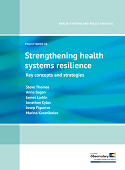Strengthening health systems resilience: key concepts and strategies (2020)

Download
This brief’s key messages are:
- Health system resilience is key to coping with catastrophic events, such as the economic crisis and the coronavirus (COVID-19) pandemic, but there is much confusion about what resilience means, how to strengthen it and how to assess it.
- For operational and assessment purposes, and to foster a more consistent understanding and use of the key concepts, we adopt the following definitions of health system resilience and shock:
- Health system resilience is the ability to prepare for, manage (absorb, adapt and transform) and learn from shocks.
- Shock is a sudden and extreme change which impacts on a health system, and is thus different from the predictable and enduring health system stresses, such as population ageing. A shock cycle has four stages: Stage 1: Preparedness; Stage 2: Shock onset and alert; Stage 3: Shock impact and management; and Stage 4: Recovery and learning.
- Based on the existing literature and emerging evidence from the ongoing COVID-19 pandemic, we identify strategies for enhancing resilience and map them on to the key health systems functions:
- Governance: effective and participatory leadership with strong vision and communication; coordination of activities across government and key stakeholders; an organizational learning culture that is responsive to crises; effective information systems and flows; and surveillance enabling timely detection of shocks and their impact.
- Financing: ensuring sufficient monetary resources in the system and flexibility to reallocate and inject extra funds; ensuring stability of health system funding through countercyclical health financing mechanisms and reserves; purchasing flexibility and reallocation of funding to meet changing needs; and comprehensive health coverage.
- Resources: appropriate level and distribution of human and physical resources; ability to increase capacity to cope with a sudden surge in demand; and motivated and well-supported workforce.
- Service delivery: alternative and flexible approaches to deliver care.
- Assessing how each function is placed in terms of the strategies above can allow a country to identify the potential sources of vulnerability and plan for further action (to enhance resilience or the capacity to respond). Resilience can also be assessed after the crisis, providing an evaluation of the handling of the crisis.
- Assessment of health system resilience is crisis- and context-specific. It is important to employ a range of both quantitative and qualitative metrics that allow evaluation of particular aspects of health system resilience in order to provide a meaningful overall assessment.
- Analysing experiences of other countries provides useful lessons for policy-makers implementing resilience-enhancing strategies. It is particularly important to learn in the aftermath of the shock and make the link between recovering from the shock to preparedness for future shocks, which is an area often neglected once the health system returns to post-shock ‘normality’.





















